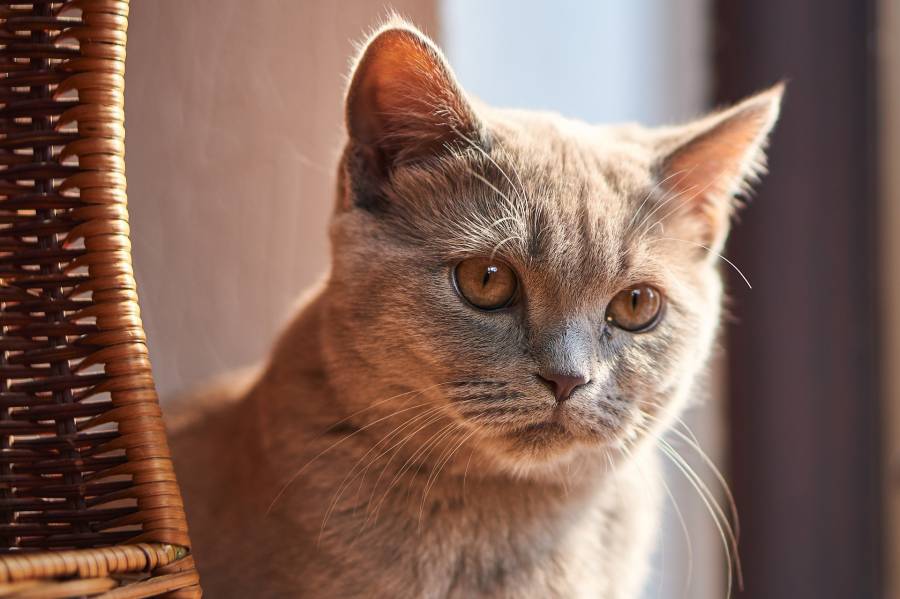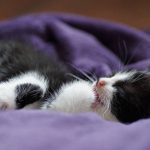Quick Navigation
The brown stuff around the cat’s mouth and lips can range from life-threatening conditions to cosmetic features.

Although many of these appearances may look harmless, it is always better to be on the safer side.
However, these strange spots make some owners puzzled about what way to go or what exactly they are.
To help that, we’ve prepared a quick guide to help you find out what this brown stuff could mean.
What Could Cause The Brown Stuff Around A Cat’s Mouth?
Feline Acne
Acne is not just a condition for humans; cats are also susceptible to this skin condition.
A dirty chin could be the result of a mild to moderate case of cat acne.
As with blackheads on people, those black specks are actually blackheads.
Cats can experience lesions and red sores on the chin area in more serious cases.
Feline acne is a common skin condition that looks like brown stuff around a cat’s mouth.
Feline acne could range from minor to extreme cases.
The skin condition develops when hair pores are blocked due to excessive production of keratin in the skin.
Your cat is likely to have red sores, hair loss, and even bleeding at severe stages, leaving brown spots around the mouth.
What Are The Common Causes Of Feline Acne?
To date, the cause of feline acne is mysteriously unknown.
Some even believe that plastic contributes to acne breakouts because the condition is most common in cats who eat from plastic bowls.
Others say age plus poor grooming can also lead to skin conditions. However, regardless of this mystery, several underlying conditions could cause the skin condition:
- Food Allergies
- Poor Immune and health condition
- Hormone Imbalance
- Poor grooming or care
- Hyperactive sebaceous glands
What To Do If Your Cat Has Feline Acne?
Although feline acne could disappear as suddenly as it first appeared, some cases require proper treatment.
However, here are a few practical measures to adopt when addressing feline acne.
You can use benzoyl peroxide facial preparation or an anti-seborrheic shampoo when cleansing the affected area and flush out the hair follicles.
In many cases, an antibiotic ointment containing mupirocin is extremely effective.
Note that it is imperative to visit the vet before administering treatments to your pets.
Also, avoid using human acne treatments on your pet, as they might have harsh reactions because of their tender skin.
- Clean the affected area: Chlorhexidine antibacterial washes can be applied at intervals in a day to disinfect the area gradually. Aloe vera can also be helpful to soothe the skin after disinfection.
- Feed Omega-3 supplements: Omega-3 is known to improve skin health and is usually recommended for feline acne.
- Replace Plastic Bowls with stainless or ceramic materials for food and water
- Use Medicated Shampoos and ointments: Mild cases of feline acne can be treated with medicated shampoos, although be sure to show it to a vet. Also, applying antimicrobial gels and ointments could turn out handy in clearing acne.
- Administered Antibiotics
Prevention Is Always Better Than Cure
Improved hygiene is frequently part of treatment.
Although the causes of feline acne are not entirely known, few measures could be taken for prevention.
Just like with humans, regular grooming is the most crucial measure against acne.
Avoiding bowls with plastic materials could also help to prevent feline acne, as plastics are known to breed bacteria quickly.
Drooling
Most cats drool, mainly when they express emotions – happy, sad, sick, or hungry. But sometimes, drooling could be a result of health problems.
The excess or dried-up drool might turn out to leave a brown (dark) stuff stain around their lips.
However, here are common reasons why your cat would likely drool:
- Happiness: Just like dogs, some cats drool in response to positive stimulation. So sometimes, when you show your pet love, the rolling over and purring may include drooling.
- Toxin Ingestion: If your cat has taken in something toxic or is allergic to its health, it may begin to drool. Also, when they have a bad-tasting substance or medication in their mouth, they could drool.
- Heat Stroke: Should your cat feel overheated, drooling can be a sign to watch out for. Ensure you visit the vet soon to ensure necessary care is administered.
Other reasons for drooling in cats could include mouth ulcers, kidney failure, difficulty swallowing, periodontal disease, and nerve damage.

What To Look Out For When Drooling Is Health-related?
Excessive drooling: When cats drool normally, they have just small droplets of saliva around their chin.
Drooling becomes pretty abnormal when you have a puddle of saliva around their lips, jaw, or on the floor.
This excessive drooling could cause skin infections with symptoms of redness or brown discoloration of skin hair around the chin.
Sudden Drooling: Another thing you should be wary of is when you suddenly find your cat drooling for the first time.
Even the slightest drool in sleep is worth investigating if your cat is not known for drooling.
What To Do If Your Cat Is Drooling
If your cat is drooling due to happiness and playfulness, there is almost nothing you can do about it.
If your cat is drooling excessively, have her checked out by a veterinarian.
Early detection is always preferable because some of these causes can be very serious.
Some medical conditions, such as dental disease, cause mouth irritation.
However, if the normal drooling becomes frequent, there is a need to visit the vet.
In the case of abnormal drooling, there is always an underlying health concern.
Cats can’t drool continuously for no just cause.
Do well to visit your vet immediately.
Lentigo
Lentigo is a genetic condition where there is an increase in pigment-producing cells on a cat’s face.
The most typical cause of these dark spots is an increase in epidermal melanocytes.
Small black or brown spots develop on your cat’s face as these cells that produce pigment grow.
As these cells increase, black spots or brown stuff show up on your cat’s face.
This condition is common with orange, tortoiseshell, yellow, calico, and flame-point-colored cats.
As a cat ages, this condition can develop on its nose, lips, and eyes.
Cats around middle age to older cats are more prone to lentigo.
Nevertheless, a year-old cat could also be a victim.
What Signs Should You Look Out For?
The early stage of lentigo often appears as tiny dots on the lips before spreading to other face parts.
As the car grows older, these spots grow more extensive and spread faster to brown-looking stuff around the chin.
As time passes, lesions begin to appear, gradually discoloring the affected areas.
These lesions are usually black or brown and small in size.
Be careful not to overlook the symptoms as the cat may remain comfortable; without itching or pain.
What Could Cause Lentigo In Cats?
While many vets may associate this condition with sun exposure, the exact cause is yet unknown.
Asides from sun exposure, there are other underlying factors or triggers to the genetic disorder.
Do well to contact your vet when lentigo is noticed.
What To Do If Your Cat Has Brown Stuff Around The Chin From Lentigo?
Lentigo is entirely harmless and normal.
However, you might need to confirm with the vet that the brown stuff isn’t anything other than lentigo.
It’s possible that the cat has a regular sun exposure; lowering sun exposure requires some trial and error.
Beyond that, lentigo requires no medical treatment as it is a cosmetic condition.
Conclusion
Fleas and flea dirt is other likely cause of the brown stuff around a cat’s mouth.
Fleas are parasites that suck blood off cats and afterward excrete on the skin of the cat.
This excreta is in a black form and could stain the skin of the cat.
Melanoma could be another possible cause.
Melanoma is an abnormality in the melanin pigment that affects cats’ fur, mouth, and eyes.
However, if you have sighted brown stuff, a strange spot, coloring, or an infection on your cat, contact your vet to fix an appointment.
Regardless of what it might be, it’s better to be safe than sorry.
A quick visit neglected should not have to cost you the life of your friend.

A passionate content creator on pet behavior, nutrition choices, and health, Mike is an experienced pet expert. He has been writing on multiple websites to compensate for his passion for cats. Mike grieves around plenty of pets in his parents’ house. At the start of his career, he had a sturdy intention to be a part of pet care by any means.
With his affiliation to Purrfect n’ Pawesome, he found a way to satiate his craving to participate in pet health, wellness, and behavior analysis. He has been a significant part of our team and a major contributor in equipping our site with useful, authentic, and research-backed articles.
“I love pets as much as I love to travel to explore multiple places and lifestyles. I have been attached to this pawsome platform for many years, and my experience regarding pets has enhanced significantly by using various devices to write articles. I believe in writing my thoughts and experiences, so I try to write down the experience and learnings for my readers no matter where I am and what my mood is.”






